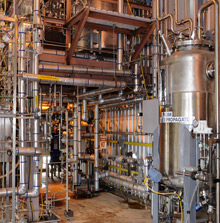You are hereBlogs / WcP.Scientific.Mind's blog / Cellulosic Ethanol Plant Opens, Uses Waste Biomass to Make Biofuel
Cellulosic Ethanol Plant Opens, Uses Waste Biomass to Make Biofuel
Original Source: Technology Review
(quote)
A biorefinery built to produce 1.4 million gallons of ethanol a year from cellulosic biomass will open tomorrow in Jennings, LA. Built by Verenium, based in Cambridge, MA, the plant will make ethanol from agricultural waste left over from processing sugarcane. It is the first demonstration-scale cellulosic ethanol plant in the United States and will be used to try out variations on the company's technology and is designed to run continuously. Verenium wants to demonstrate that it can create ethanol for $2 a gallon, which it hopes will make the fuel competitive with other types of ethanol and gasoline. Next year, the company plans to begin construction on commercial plants that will each produce about 20 to 30 million gallons of ethanol a year. Until now, technology for converting nonfood feedstocks into ethanol has been limited to the lab and to small-scale pilot plants that can produce thousands of gallons of ethanol a year. Since these don't operate continuously, they don't give an accurate idea of how much it will ultimately cost to produce cellulosic ethanol in a commercial-scale facility.
Almost all ethanol biofuel in the United States is currently made from corn kernels. But the need for cellulosic feedstocks of ethanol has been underscored recently as food prices worldwide have risen sharply, in part because of the use of corn as a source of biofuels. At the same time, the rising cost of corn and gas have begun to make cellulosic ethanol more commercially attractive, says Wallace Tyner, a professor of agricultural economics at Purdue University. A new Renewable Fuels Standard, part of an energy bill that became law late last year, mandates the use of 100 million gallons of cellulosic biofuels by 2010, and 16 billion by 2022.
So far, however, there are no commercial-scale cellulosic ethanol plants in operation in the United States, although a number of facilities are scheduled to start production in the next few years. The Department of Energy is currently funding more than a dozen companies that will be building demonstration- and commercial-scale plants. One of these, Range Fuels, based in Broomfield, CO, plans to open a commercial-scale plant next year. It will have the capacity to produce 20 million gallons of ethanol and methanol a year. Verenium will use a combination of acid pretreatments, enzymes, and two types of bacteria to make ethanol from the plant matter--called bagasse--that's left over from processing sugarcane to make sugar. It will also process what's called energy cane, a relative of sugarcane that's lower in sugar and higher in fiber. The high fiber content allows the plants to grow taller, increasing yield from a given plot of land.
The opening of the demonstration plant, and the current construction of a number of other demonstration- and commercial-scale cellulosic ethanol plants, marks a turning point for the industry, Riva says. The development of improved enzymes and fermentation organisms means that no further scientific breakthroughs are needed to make cellulosic ethanol commercially successful, he says. "There's been a tremendous amount of background work in science and technology development," he says. "We've learned so much about the process that the really important thing now is to start to deploy the technology at a commercial scale."
(unquote)



















